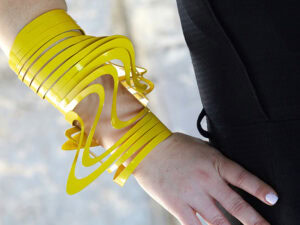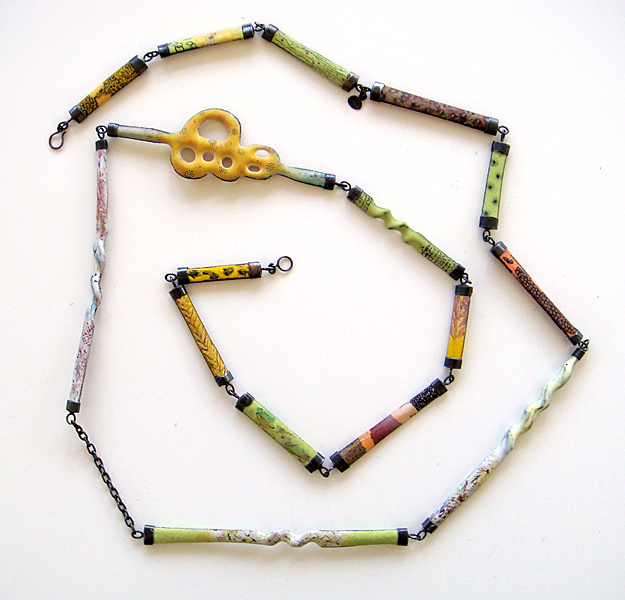
Susan Cummins: Jamie, can you tell me the story of how you became a jeweler?
Jamie Bennett: Once I finished undergraduate school with a business degree from The University of Georgia, I began taking art classes there. I was thrilled with the freedom I sampled by taking painting, ceramics, sculpture, and jewelry. Though I had only taken one class in jewelry, the intimacy, the particular type of making, and these objects all appealed to me. And I realized I already had a connection, which perhaps instigated my interest.
When I was younger, I would go with my mother who annually bought cufflinks as a birthday present for her brother. She would often go to Paul Sargent on West 4th Street and Sam Kramer on West 8th Street, both modern jewelers with stores in Greenwich Village. I remember the cast hand-shaped door handle at Kramer’s and the basket below his jewelry counter filled with glass eyeballs. These visits and the work stuck with me.
You have worked with enamel most of your career, but when you began, I believe enamel was relegated to the hobby shops of America. How did you make the decision to use it?
I knew little of hobby-shop enamelwork, although I did purchase a Raggedy Andy enamel plaque at the Washington Square art fair when I was about 10. Outside of this experience, my exposure to enamel was at The Metropolitan Museum of Art, The Morgan Library & Museum, and of course, The Cloisters. I really cannot give a reason or conjure up a memory why, but I loved the Byzantine and medieval enamelwork. The first time I used it was in a required class in graduate school with Kurt Matzdorf. I have to say it did not go well, both the outcome and my resolve to continue. However, I had already signed up for a class with Bill Harper at Penland School of Crafts, so I continued. Bill was a great supporter and teacher. From that point, my experience would define my medium.

What attracts you to enamel, and how have attitudes toward it changed in your lifetime?
Enamel was invented as an art material meant to mimic jewels. I think that its preciousness got the better of it over time. As I began to work with enamel, I realized it wasn’t the processes associated with enamel, such as cloisonné, I was interested in, but the characteristics of the material itself. It has great visual and tactile breadth. This still challenges me and provides, within the context of a specific practice, a fair range of possible outcomes.
This body of work is called Among Etcetera. What does that reference?
I really do not try to make things that appear as whole or complete, both in the surface imagery and in the forms I use. I work by accumulating from varied sources, some tangible and some not. In my mind, they are like frames from a film. I begin to juxtapose them in no particular order. These are fragments or glimpses, not complete on their own, but I hope compelling and suggestive in their mutual presence. I believe the basis of their meaning is in the want and the act of putting such things on the body.
Over and over, we have had the need to put meaningful expressions on our body, emblematically and otherwise. This repeated act, this simultaneously communal and individual act, is quite critical. My title for the series, Among Etcetera, comes from Umberto Eco’s book The Infinity of Lists. In it, Eco suggests the word etcetera does not merely or externally mean “and so on,” but within the context of the infinite list, it means among things.
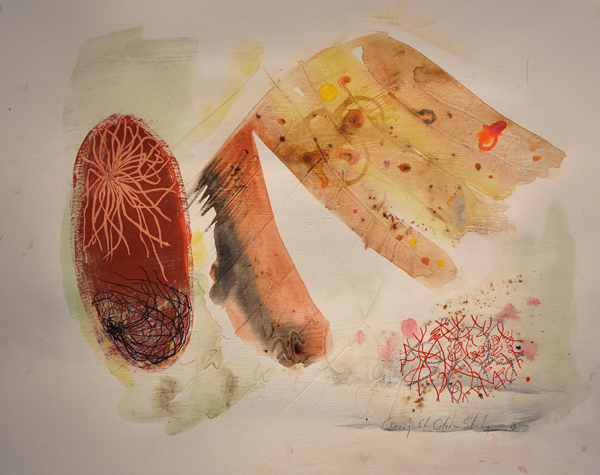
These drawings are not necessarily preparatory or specific studies for jewelry. But, they are about studying. Enameling can be very procedural, and it lends itself to set patterns and practices. I am not interested in my work having that formality. Drawing reminds me how important the act of a gesture is, and I guess I need that reminder. Drawing is also my archive. It is my inventory of ideas. I show the drawings with the jewelry to suggest their reciprocal influence. They do not need each other, but I do like to look at them together.
You have been teaching at SUNY (State University of New York) New Paltz for many years, and I am wondering if you can reflect on your life as a professor.
I guess I should start being reflective at this point. I have done a fair amount of “what if?” thinking over the years with regards to the paths I have chosen as an artist, but as an educator, I don’t recall asking myself that question. What has always been first to me, professionally, is I am an artist. How I have acted, taught, and invented as a professor reflects that priority and vanity.
I am not going to rant on about how much harder it is to be an artist/ academic today. Everyone knows that. But if you make that decision, as I did, you have to figure out how to make it work. Otherwise, you will be miserable in one, the other, or both. I made a decision that if I was going to teach, then it was going to be as an activist. Thinking you can make a difference and putting ideas and challenges out there are a lot more compelling reasons to teach than showing people how to load a saw frame. Not that it is not important, but it would not sustain me.
As an academic/artist, I also learned that there are important similarities between the two—particularly when we are talking about teaching the MFA, which is our professional degree. I believe making art is both a positive and negative activity. You work as much against something as you work to something. Teaching, for me, is exactly the same. It can be, and sometimes must be, against something in order to create the tension necessary for change.
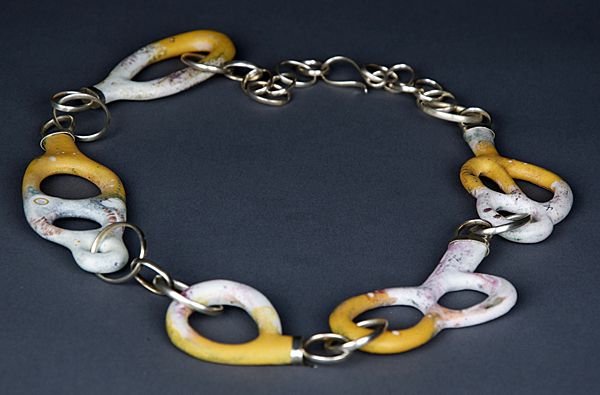
Being an artist and an educator for a lifetime is, what … ? My first thought is, “how did that combination come up in the first place?” Years ago, a painting friend told me he had to quit his position at Rutgers University because no galleries would take him seriously. Art and academia is a difficult brew, but through teaching I have learned more about myself as an artist, and through the trials and errors of being an artist, I have learned more about mentoring.
This will be the 40th September I begin in front of students in a laboratory for learning, thinking, and making. I live with books and art supplies. I am not complaining.
Can you give an example of an assignment that challenged your students to make their best work?
God, I wish I had a magic wand that could give me that capacity! My colleague Myra Mimlitsch Gray and I wrench ourselves trying to figure out the best strategy to get the biggest bang for the critical buck. That is a tough one.
We really do not give assignments to MFA students. Rather, we give them a few motivational tools, such as over the summer make 100 drawings, whose subjects can be your burning issue. Then, following a fall critique, make 10 pieces in one week that respond to the dialogue around your drawings. Begin!
One undergraduate assignment I enjoyed for the P & E (process and experiment) class was titled “Counterfeit, Camouflage, and Codified.” Like many of our assignments, this one called for both the skill to make a convincing object and a smart wit and strategy to answer the assignment. I show slides, discuss alternatives, define the subject matter, and we begin. One student—I think it was Amelia Toekle—made an almost exact counterfeit of one of my pieces. How do you critique that? Perfect. I would not say this piece was a particularly important one in her work, but it might have acted as a catalyst for her later work, which again made use of her inventive and satirical mind. When you see a propensity, it is important to nurture it.
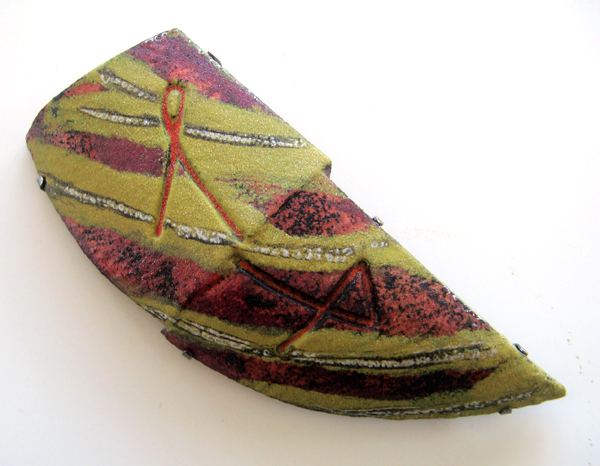
European galleries represent almost no American jewelers, yet you have managed to find a partner in Italy. Can you tell the story of how you and Antonella Villanova found each other?
Galleries in Europe represent some American work, but it is very rare indeed for an American to have a solo show. I can think of only a handful. I will reserve comment on that. I have never gone to Europe strategically. I go because I enjoy it, and I get a great deal of satisfaction being among other artists. I am in Europe almost every year. I have been to Munich for the Schmuck fair or for other jewelry events more than a dozen times going back to the early 1980s. Being in Europe and meeting the galleries and the artists is rewarding on a very personal level, and even professionally.
My introduction to Antonella Villanova and her gallery was a result of first meeting and becoming friends with Doris Maninger and Lucia Massel, co-directors of Alchimia, the contemporary jewelry school in Florence, Italy. In 2010, my partner Anat and I were holidaying in Tuscany and arranged to visit Alchimia, where I gave an informal lecture on my work. Lucia, Doris, and Ruudt Peters, who was teaching there at the time, urged me to show my work to Antonella, whose gallery in Florence was showing contemporary jewelry. They believed she would like the work because she was clearly interested in pieces that had a painterly sensibility. She was already showing Manfred Bischoff and Ruudt Peters. They made the phone call, and I went to visit.
It was clear to me that Antonella Villanova was a good fit for my work, which, of course, is important. I made plans to send her some. That was in October. The following March we were planning to meet in Munich. I was to deliver some pieces, and we were to plan an exhibition. That did not come to pass, so after some consideration, I changed my schedule and flew to Florence for the day. The show is the result of our planning and agreeing. We are simpatico.
Are there any particular jewelry books you would like to recommend?

The greatest need is in the critical sphere, however. What contemporary jewelry is, and what is it good for, are important questions. I have only read bits and pieces from On Jewellery by Liesbeth den Besten, so I can’t speak to its value. From what I have read and what I sense from the book, perhaps prematurely, is a high degree of celebrating sensationalism and theatricality in jewelry, seemingly for its own sake. Over-the-top has always been present in the culture of jewelry, both high and low, but one should question it critically. Is this simply meant to be provocative in the maker’s or writer’s hand? Is it truly intelligent work or observation? Is it relevant to a jewelry experience? I would also add that much of jewelry’s performance work and body art should be contextualized and understood in relation to the works of earlier artists outside of metal, such as Hanna Wilke, Rebecca Horn, Ann Hamilton, and Jeannine Antoni. I look forward to reading the new AJF book edited by Damian Skinner, which is coming out soon (Contemporary Jewelry in Perspective, August 2013).
I do have two other thoughts about what I would recommend. I am probably more interested in books around jewelry or in jewelry but not necessarily about jewelry. There are excellent books, such as The Language of Ornament by James Trilling; The Craftsman by Richard Sennett; Beauty and the Contemporary Sublime by Jeremy Gilbert-Rolfé; Extra/Ordinary by Maria Elena Buszek; Under Blue Cup by Rosalind E. Krauss; and From Head to Hand by David Levi Strauss.
I also advocate reading monographs on artists. In the catalog Uber den Schmuck, Hermann Jünger’s thoughts on making are inspiring. Read through Peter Bauhuis’s Abecedarium or Kim Buck’s It’s the Thought That Counts. Otto Kunzli’s new exhibition catalog, called The Book, has some great essays. As a maker, it is always more interesting to see how an individual thinks rather than what someone else thinks of him or her. Ah, one final classic that I believe all jewelers should read is E. T. A. Hoffmann’s Mademoiselle de Scudery—a tale of theft and murder all in the name of a jewelry collector and a goldsmith.
Thank you.



